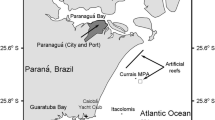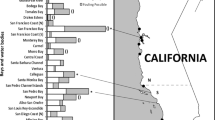Abstract
Measures taken to control the spread of non-indigenous species by human vectors may act selectively by providing effective protection against some (but not all) species. Toxic ‘antifouling paints’ are used by boat owners to prevent the development of ‘fouling assemblages’ on the hulls of their boats, which reduce vessel speed and maneuverability. By reducing fouling, these paints also prevent transport of non-indigenous species. Using experimental surfaces mimicking boat hulls, we evaluated the effectiveness and selectivity of (1) antifouling paints, and (2) manual, in-water hull cleaning for preventing the transport of marine sessile invertebrates by recreational vessels. Different types of antifouling paints provided effective protection only against barnacles and bivalves. Other fouling taxa occurred on experimental surfaces after a period of only 2 months. Manual hull cleaning did not remove fouling completely, and even enhanced the risk of subsequent recruitment by some fouling organisms. Up to six times more individuals and colonies recruited to boat surfaces from which the existing fouling organisms had been removed manually than to surfaces that had been sterilized or contained intact fouling assemblages. Bivalves, colonial and solitary ascidians, encrusting bryozoans, hydroids, tubiculous polychaetes, and sponges consistently recruited in greatest abundance to manually cleaned surfaces. Individual taxa responded in complex, but predictable ways to the biogenic cues left by manual cleaning, so that different suites of organisms colonized surfaces that had originally contained fouling assemblages of local or non-local origin. Our study shows that widely adopted measures to control the spread of non-indigenous species by human vectors are often highly selective and, while effective for some taxa, do not prevent the transport of others.
Similar content being viewed by others
References
AMOG Consulting (2002) Hull fouling as a vector for the translocation of marine organisms. Phase I: Hull fouling research. Ballast Water Research Series, Report No. 14 Department of Agriculture, Fisheries and Forestry Australia, Canberra, 142 pp
ANZECC (1996) Working Together to Reduce Impacts from Shipping Operations: Code of Practice for Antifouling and In-water Hull Cleaning and Maintenance. Australian and New Zealand Environment and Conservation Council, Canberra, 10 pp
Biggelaar T (1998) Understanding antifouling. Offshore July: 30–33
Bird CJ, Dadswell MJ and Grund DW (1993) First record of the potential nuisance alga Codium fragile ssp. tomentosoides (Chlorophyta, Caulerpales) in Atlantic Canada. Proceedings of the Nova Scotian Institute of Science 40: 11–17
JR Bray JY Curtis (1957) ArticleTitleAn ordination of the upland forest communities of southern Wisconsin Ecological Monographs 27 325–349
PJ Bryan PY Qian JL Kreider FS Chia (1997) ArticleTitleInduction of larval settlement and metamorphosis by pharmacological and conspecific associated compounds in the serpulid polychaete Hydroides elegans Marine Ecology Progress Series 146 81–90 Occurrence Handle1:CAS:528:DyaK2sXivVals74%3D
Bureau of Rural Sciences (1999) National policy for the translocation of live aquatic organisms – issues, principles and guidelines for implementation. Consultation Paper for the Ministerial Council on Forestry, Fisheries and Aquaculture. Agriculture, Fisheries and Forestry Australia, Canberra
RD Burke (1986) ArticleTitlePheromones and the gregarious settlement of marine invertebrate larvae Bulletin of Marine Science 39 323–331
MA Champ FL Lowenstein (1987) ArticleTitleTBT: the dilemma of antifouling paints Oceanus 30 69–77
AO Christie R Dalley (1987) Barnacle fouling and its prevention AJ Southward (Eds) Barnacle Biology A.A. Balkema Rotterdam, The Netherlands 419–433
HJ Cranfield DP Gordon RC Willan BA Marshall CN Battershill MP Francis WA Nelson CJ Glasby GB Read (1998) Adventive marine species in New Zealand. NIWA Technical Report 34 National Institute of Water and Atmospheric Research Wellington 48
DJ Crisp (1979) Dispersal and re-aggregation in sessile marine invertebrates, particularly barnacles G Larwood BR Rosen (Eds) Biology and Systematics of Colonial Organisms Academic Press London 319–328
JA Crooks ME Soulé (1999) Lag times in population explosions of invasive species: causes and implications OT Sandlund PJ Schei A Viken (Eds) Invasive Species and Biodiversity Management Kluwer Academic Publishers Dordrecht, The Netherlands 103–124
NA Davidson ND Stone (1989) Imported fire ants DL Dahlsten (Eds) Eradication of Exotic Pests: Analysis with Case Histories Yale University Press New Haven, CT 196–214
M Dickman FZ Zhang (1999) ArticleTitleMid-ocean exchange of container vessel ballast water. 2: Effects of vessel type in the transport of diatoms and dinoflagellates from Manzanillo, Mexico, to Hong Kong, China Marine Ecology-Progress Series 176 253–262
Environment Committee Natural Resources (1997) Report on Ballast Water and Hull Fouling in Victoria Victorian Government Printer Melbourne 220
RA Everett (2000) ArticleTitlePatterns and pathways of biological invasions Trends in Ecology and Evolution 15 177–178 Occurrence Handle10.1016/S0169-5347(00)01835-8
D Field (1999) ArticleTitleDisaster averted? Black striped mussel outbreak in northern Australia Fish Farming International 26 30–31
RL Fletcher P Farrell (1998) ArticleTitleIntroduced brown algae in the North East Atlantic, with particular respect to Undaria pinnatifida (Harvey) Suringar Helgoländer Meeresuntersuchungen 52 259–275
Floerl O (2002) Intracoastal spread of fouling organisms by recreational vessels. PhD Thesis. James Cook University, Townsville, Queensland 287 pp
Floerl O and Inglis GJ (2000) Marine bioinvasions: quantifying the potential of a transfer vector by analysing its relationship with the donor region. Paper Presented at the ICES 2000 Annual Science Conference, September 25–29, Bruges, Belgium
O Floerl GJ Inglis (2003) ArticleTitleBoat harbour design can exacerbate hull fouling Austral Ecology 28 116–127 Occurrence Handle10.1046/j.1442-9993.2003.01254.x
Glasby TM (1997) Influences of marinas on subtidal epibiotic assemblages. PhD Thesis. University of New South Wales, Sydney, 231 pp
RK Grosberg (1981) ArticleTitleCompetitive ability influences habitat choice in marine invertebrates Nature 290 700–702 Occurrence Handle10.1038/290700a0
JP Hamer IAN Lucas TA McCollin (2001) ArticleTitleHarmful dinoflagellate resting cysts in ships’ ballast tank sediments: potential for introduction into English and Welsh waters Phycologia 40 246–255
CH Hay (1990) ArticleTitleThe dispersal of sporophytes of Undaria pinnatifida by coastal shipping in New Zealand, and implications for further dispersal of Undaria in France British Phsycological Journal 25 301–313
CL Hewitt ML Campbell RE Thresher RB Martin (1999) Marine biological invasions of Port Phillip Bay, Victoria Technical Report No. 20. CSIRO Marine Research Centre for Research on Introduced Marine Pests Hobart 344
Hunter JE and Anderson CD (2001) Antifouling Paints and the Environment. International Marine Coatings Technical Paper. Available at http://www.international-marine.com
IMO (1999) Anti-fouling systems moving towards the non-toxic solution. Focus on IMO. International Maritime Organization, 24 pp
EW Knight-Jones DJ Crisp (1953) ArticleTitleGregariousness in barnacles in relation to the fouling of ships and to anti-fouling research Nature 171 1109–1110 Occurrence Handle1:STN:280:CyyD1Mjlt1Q%3D Occurrence Handle13072503
CS Kolar DM Lodge (2001) ArticleTitleProgress in invasion biology: predicting invaders Trends in Ecology and Evolution 16 199–204 Occurrence Handle10.1016/S0169-5347(01)02101-2 Occurrence Handle11245943
CC Lambert G Lambert (1998) ArticleTitleNon-indigenous ascidians in southern California harbours and marinas Marine Biology 130 675–688 Occurrence Handle10.1007/s002270050289
J Lützen (1999) ArticleTitleStyela clava Herdman (Urochordata, Ascidiacea), a successful immigrant to North West Europe: ecology, propagation, and chronology of spread Helgoländer Meeresuntersuchungen 52 383–391
RN Mack D Simberloff WM Lonsdale H Evans M Clout FA Bazzaz (2000) ArticleTitleBiotic invasions: causes, epidemiology, global consequences, and control Ecological Applications 10 689–710
MAF (2003) The Biosecurity Strategy for New Zealand. Ministry of Agriculture and Forestry, New Zealand, Wellington, 67 pp. Available at http://www.maf.govt.nz/biosecurity-strategy
Marine Science & Ecology (2002) Hull fouling as a vector for the translocation of marine organisms. Phase III: the significance of the prospective ban on tributyltin antifouling paints on the introduction and translocation of marine pests in Australia. Ballast Water Research Series, Report No. 15. Department of Agriculture, Fisheries and Forestry Australia, Canberra, 133 pp
JR Marsden (1991) ArticleTitleResponses of planktonic larvae of the serpulid polychaete Spirobranchus polycerus var. augeneri to an alga, adult tubes, and conspecific larvae Marine Ecology-Progress Series 71 245–251
McClary DJ and Nelligan RJ (2001) Alternate biosecurity management tools for vector threats: technical guidelines for acceptable hull cleaning facilities. Kingett Mitchell & Associates, Report Prepared for the New Zealand Ministry of Fisheries (Project ZBS2000/03), 29 pp
RW Osman RB Whitlatch (1995a) ArticleTitleThe influence of resident adults on larval settlement: experiments with four species of ascidians Journal of Experimental Marine Biology and Ecology 190 199–220 Occurrence Handle10.1016/0022-0981(95)00036-Q
RW Osman RB Whitlatch (1995b) ArticleTitleThe influence of resident adults on recruitment: a comparison to settlement Journal of Experimental Marine Biology and Ecology 190 169–198 Occurrence Handle10.1016/0022-0981(95)00035-P
JR Pawlik (1992) ArticleTitleChemical ecology of the settlement of benthic marine invertebrates Oceanography and Marine Biology Annual Reviews 30 273–335
PY Qian (2000) ArticleTitleLarval settlement and metamorphosis of Hydroides elegans in response to chemical cues Bulletin of Marine Science 67 671–672
IJ Radford RD Cousens (2000) ArticleTitleInvasiveness and comparative life-history traits of exotic and indigenous Senecio species in Australia Oecologia 125 531–542 Occurrence Handle10.1007/s004420000474
M Rejmánek (1996) ArticleTitleA theory of seed plant invasiveness: the first sketch Biological Conservation 78 171–181 Occurrence Handle10.1016/0006-3207(96)00026-2
G Rigby G Hallegraeff (1994) ArticleTitleThe transfer and control of harmful marine organisms in shipping ballast water: behaviour of marine plankton and ballast water exchange trials on the MV Iron Whyalla Journal of Marine Environmental Engineering 1 91–110
B Rinkevich IL Weissman (1987) ArticleTitleThe fate of Botryllus (Ascidiacea) larvae cosettled with parental colonies: beneficial or deleterious consequences Biological Bulletin 173 474–488
BG Tabachnick LS Fidell (1996) Using Multivariate Statistics Harper Collins New York 880
AJ Underwood (1981) ArticleTitleTechniques of analysis of variance in experimental marine biology and ecology Oceanography and Marine Biology Annual Reviews 19 513–605
AJ Underwood (1997) Experiments in Ecology: Their Logical Design and Interpretation Using Analysis of Variance Cambridge University Press Cambridge 504
BJ Winer DR Brown KM Michels (1991) Statistical Principles in Experimental Design McGraw-Hill New York 1057
MJ Wonham JT Carlton GM Ruiz LD Smith (2000) ArticleTitleFish and ships: relating dispersal frequency to success in biological invasions Marine Biology 136 1111–1121 Occurrence Handle10.1007/s002270000303
MJ Wonham WC Walton GM Ruiz AM Frese BS Galil (2001) ArticleTitleGoing to the source: role of the invasion pathway in determining potential invaders Marine Ecology-Progress Series 215 1–12
ES Zavaleta RJ Hobbs HA Mooney (2001) ArticleTitleViewing invasive species removal in a whole-ecosystem context Trends in Ecology and Evolution 16 454–461 Occurrence Handle10.1016/S0169-5347(01)02194-2
FZ Zhang M Dickman (1999) ArticleTitleMid-ocean exchange of container vessel ballast water. 1: seasonal factors affecting the transport of harmful diatoms and dinoflagellates Marine Ecology-Progress Series 176 243–251
Author information
Authors and Affiliations
Corresponding author
Rights and permissions
About this article
Cite this article
Floerl, O., Inglis, G.J. & Marsh, H.M. Selectivity in vector management: an investigation of the effectiveness of measures used to prevent transport of non-indigenous species. Biol Invasions 7, 459–475 (2005). https://doi.org/10.1007/s10530-004-4863-5
Received:
Accepted:
Issue Date:
DOI: https://doi.org/10.1007/s10530-004-4863-5




